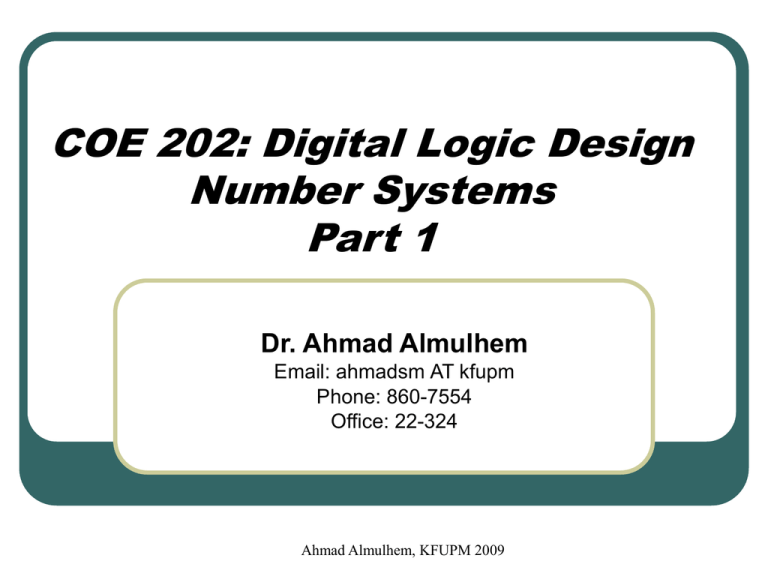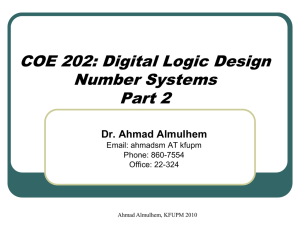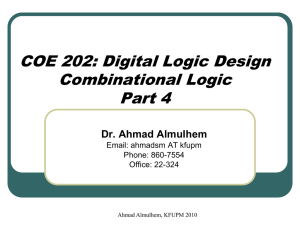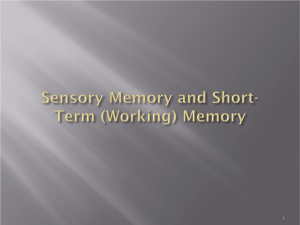ppt
advertisement

COE 202: Digital Logic Design
Number Systems
Part 1
Dr. Ahmad Almulhem
Email: ahmadsm AT kfupm
Phone: 860-7554
Office: 22-324
Ahmad Almulhem, KFUPM 2009
Objectives
1.
2.
3.
4.
Weighted (positional) number systems
Features of weighted number systems.
Commonly used number systems
Important properties
Ahmad Almulhem, KFUPM 2009
Introduction
• A number system is a set of numbers together with
one or more operations (e.g. add, subtract).
• Before digital computers, the only known number
system is the decimal number system ()النظام العشري
– It has a total of ten digits: {0,1,2,….,9}
• From the previous lecture:
– Digital systems deal with the binary system of
numbering i.e. only 0’s and 1’s
– Binary system has more reliability than decimal
• All these numbering systems are also referred to as
weighted numbering systems
Ahmad Almulhem, KFUPM 2009
Weighted Number System
• A number D consists of n digits and each digit has a position.
• Every digit position is associated with a fixed weight.
• If the weight associated with the ith. position is wi, then the value of
D is given by:
D = dn-1 wn-1 + dn-2 wn-2 + ……+ d1 w1 + d0 w0
• Also called positional number system
Ahmad Almulhem, KFUPM 2009
Example
9375
• The Decimal number system is a weighted number system.
• For Integer decimal numbers, the weight of the rightmost digit (at
position 0) is 1, the weight of position 1 digit is 10, that of position 2
digit is 100, position 3 is 1000, etc.
Ahmad Almulhem, KFUPM 2009
The Radix (Base)
• A digit di, has a weight which is a power of some constant value
called radix (r) or base such that wi = ri.
• A number system of radix r, has r allowed digits {0,1,… (r-1)}
• The leftmost digit has the highest weight and called Most
Significant Digit (MSD)
• The rightmost digit has the lowest weight and called Least
Significant Digit (LSD)
Ahmad Almulhem, KFUPM 2009
Example
• Decimal Number
System
• Radix (base) = 10
• wi = ri, so
–
–
–
–
w0 = 100 = 1,
w1 = 101 = 10
.
wn = rn
• Only 10 allowed digits
{0,1,2,3,4,5,6,7,8,9}
Ahmad Almulhem, KFUPM 2009
Fractions (Radix point)
• A number D has n integral digits and m fractional digits
• Digits to the left of the radix point (integral digits) have
positive position indices, while digits to the right of the
radix point (fractional digits) have negative position
indices
• The weight for a digit position i is given by wi = ri
Ahmad Almulhem, KFUPM 2009
Example
• For D = 57.6528
– n=2
– m=4
– r = 10 (decimal number)
• The weighted
representation for D is:
i = -4
diri = 8 x 10-4
i = -3
diri = 2 x 10-3
i = -2
diri = 5 x 10-2
i = -1
diri = 6 x 10-1
i= 0
diri = 7 x 100
i= 1
diri = 5 x 101
4
0.04
Ahmad Almulhem, KFUPM 2009
Notation
A number D with base r can be denoted as (D)r,
Decimal number 128 can be written as (128)10
Similarly a binary number is written as (10011)2
Question: Are these valid numbers?
• (9478)10
• (1289)2
• (111000)2
• (55)5
Ahmad Almulhem, KFUPM 2009
Common Number Systems
•
•
•
•
Decimal Number System (base-10)
Binary Number System (base-2)
Octal Number System (base-8)
Hexadecimal Number System (base-16)
Ahmad Almulhem, KFUPM 2009
Binary Number System (base-2)
r=2
Two allowed digits {0,1}
A Binary Digit is referred to as bit
Examples: 1100111, 01, 0001, 11110
The left most bit is called the Most Significant Bit
(MSB)
The rightmost bit is called the Least Significant Bit
(LSB)
11110
Most Significant Bit
Least Significant Bit
Ahmad Almulhem, KFUPM 2009
Binary Number System (base-2)
• The decimal equivalent of a binary number can be
found by expanding the number into a power series:
Example
Question:
What is the decimal equivalent
of (110.11)2 ?
Ahmad Almulhem, KFUPM 2009
Octal Number System (base-8)
r=8
Eight allowed digits {0,1,2,3,4,5,6,7}
Useful to represent binary numbers indirectly
Octal and binary are nicely related; i.e 8 = 23
Each octal digit represent 3 binary digits (bits)
Example: (101)2 = (5)8
Getting the decimal equivalent is as usual
Example
Ahmad Almulhem, KFUPM 2009
Hexadecimal Number System
(base-16)
r = 16
16 allowed digits {0,1,2,3,4,5,6,7,8,9,A,B,C,D,E,F}
Useful to represent binary numbers indirectly
Hex and binary are nicely related; i.e 16 = 24
Each hex digit represent 4 binary digits (bits)
Example: (1010)2 = (A)16
Getting the decimal equivalent is as usual
Example
Ahmad Almulhem, KFUPM 2009
Examples
Question: What is the result of adding
1 to the largest digit of some
number system?
• (9)10 + 1 = (10)10
• (7)8 + 1 = (10)8
• (1)2 + 1 = (10)2
• (F)16 + 1 = (10)16
Conclusion: Adding 1 to the largest
digit in any number system always
has a result of (10) in that number
system.
Ahmad Almulhem, KFUPM 2009
Examples
Question: What is the largest value representable using
3 integral digits?
Answer: The largest value results when all 3 positions
are filled with the largest digit in the number system.
–
–
–
–
For the decimal system, it is (999)10
For the octal system, it is (777)8
For the hex system, it is (FFF)16
For the binary system, it is (111)2
Ahmad Almulhem, KFUPM 2009
Examples
Question: What is the result of adding 1 to the largest 3-digit
number?
– For the decimal system, (1)10 + (999)10 = (1000)10 = (103)10
– For the octal system, (1)8 + (777)8 = (1000)8 = (83)10
In general, for a number system of radix r, adding 1 to the largest
n-digit number = rn
Accordingly, the value of largest n-digit number = rn -1
Ahmad Almulhem, KFUPM 2009
Important Properties
• The number of possible digits in any number
system with radix r equals r.
• The smallest digit is 0 and the largest digit has
a value (r - 1)
– Example: Octal system, r = 8, smallest digit = 0,
largest digit = 8 – 1 = 7
• The Largest value that can be expressed in n
integral digits is (r n - 1)
– Example: n = 3, r = 10, largest value = 103 -1 = 999
Ahmad Almulhem, KFUPM 2009
Important Properties
• The Largest value that can be expressed in
m fractional digits is (1 - r -m)
– Example: n=3, r = 10, largest value = 1-10-3 = 0.999
• Largest value that can be expressed in n
integral digits and m fractional digits is equal
to (r n – r -m)
• Total number of values (patterns)
representable in n digits is r n
– Example: r = 2, n = 5 will generate 32 possible unique
combinations of binary digits such as (00000 ->11111)
– Question: What about Intel 32-bit & 64-bit processors?
Ahmad Almulhem, KFUPM 2009
Conclusions
A weighted (positional) number system has a radix
(base) and each digit has a position and weight
Commonly used number systems are decimal,
binary, octal, hexadecimal
A number D with base r can be denoted as (D)r,
To convert from base-r to decimal, use
( D) r
n 1
d r
i m
i
i
Weighted (positional) number systems have
several important properties
Ahmad Almulhem, KFUPM 2009











